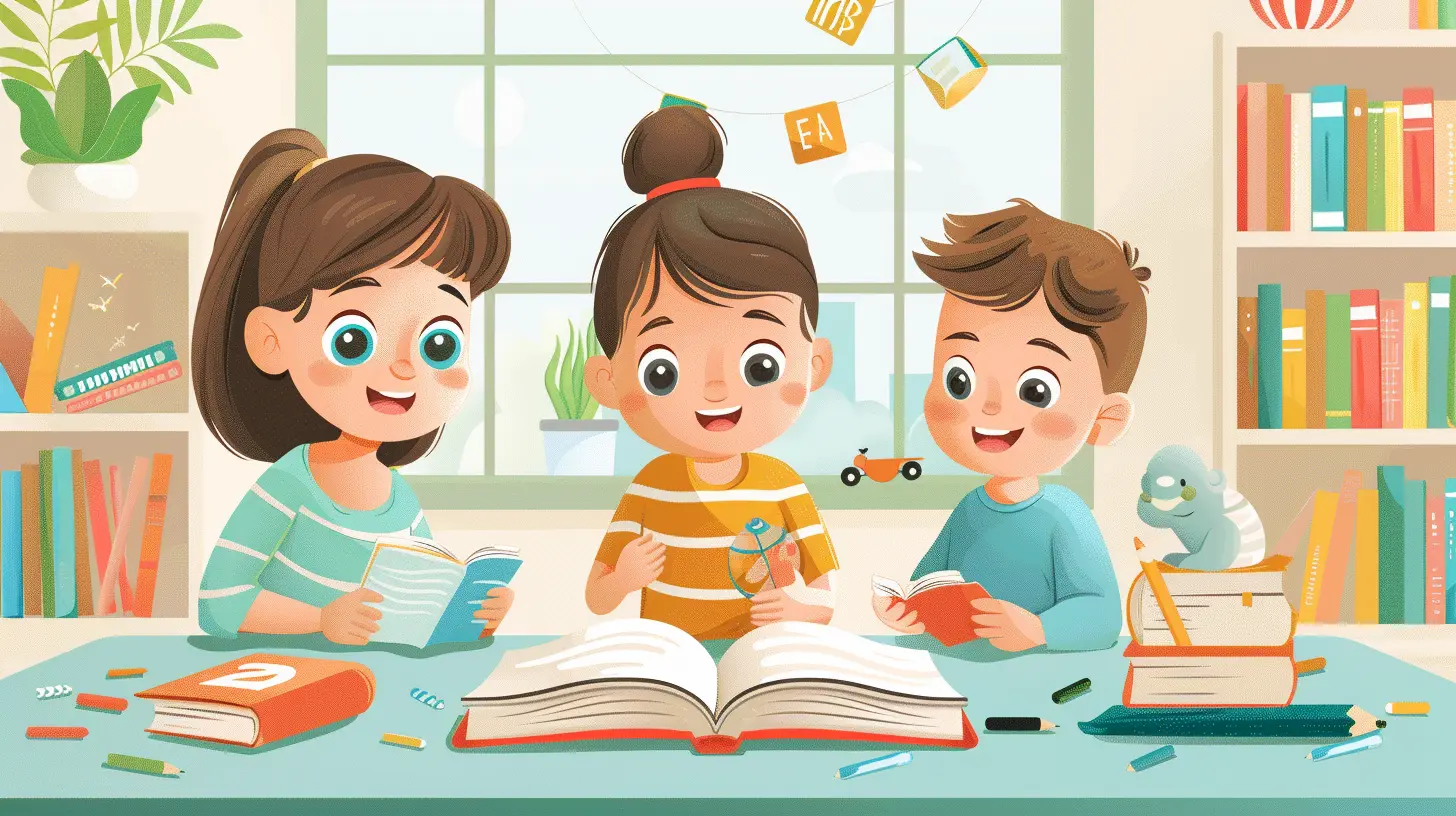Ways to Make Learning Fun for Your Kids at Home
29 May 2025
Learning at home doesn’t have to feel like a chore for kids—or for you. In fact, it can be an exciting adventure filled with creativity, laughter, and discovery. The secret? Making learning fun!
If you've ever struggled to keep your child engaged with schoolwork or educational activities, you're not alone. Kids naturally prefer play over worksheets. But what if we could combine the two? The good news is that learning and fun go hand in hand when you use the right approach.
Let’s dive into some of the best ways to make learning fun for your kids at home!

1. Turn Lessons into Games
Kids love games. Whether it's board games, video games, or simple playground activities, games keep them engaged and excited. Why not apply the same principle to learning?- Math Bingo – Instead of regular math drills, turn numbers into a game. Create bingo cards with math problems and have your child solve them to mark off squares.
- Spelling Scramble – Write letters on small pieces of paper, mix them up, and have your child form words.
- Jeopardy-Style Quizzes – Make a fun trivia game with categories like Science, History, or Vocabulary.
When learning feels like playing, kids don’t even realize they’re learning!

2. Get Hands-On with Experiments and Crafts
Textbooks are great, but kids learn best when they can see, touch, and create things themselves. Hands-on activities make abstract concepts real and memorable.- Science Experiments – Simple experiments, like baking soda and vinegar volcanoes, can spark curiosity and teach basic chemistry.
- DIY Art Projects – Use arts and crafts to reinforce lessons. For example, if your child is learning about animals, have them create a habitat diorama.
- Building Challenges – Give your child LEGO bricks or other building materials and challenge them to build structures related to their lessons, like bridges or famous landmarks.
By involving their senses, kids absorb information in a way that sticks.

3. Incorporate Music and Movement
Sitting still for long periods? Not exactly a child's strong suit. Incorporating movement and music into learning can work wonders.- Dance to Educational Songs – There are plenty of catchy songs that help kids remember multiplication tables, the alphabet, and even science facts.
- Act It Out – Learning about a historical event? Have your child put on a mini-play to act out the story.
- Exercise While Studying – Let your child use a jump rope while reciting spelling words or do jumping jacks between math problems.
The more active they are while learning, the more engaged they'll be.

4. Make Reading an Adventure
Some kids love to read, while others need a little encouragement. Instead of forcing it, turn reading into an engaging activity.- Create a Cozy Reading Corner – A special nook with pillows, blankets, and good books can make reading more enjoyable.
- Let Them Choose Books – Allowing kids to pick their own books makes them more excited to read.
- Use Audiobooks and Storytelling – If your child struggles with reading, audiobooks can bring stories to life. You can also take turns telling stories to boost their imagination.
- Act Out Stories – Encourage your child to dress up and act as their favorite book characters.
Reading becomes fun when it’s more than just words on a page.
5. Take Learning Outdoors
Who says learning has to happen indoors? Nature offers endless opportunities for education.- Scavenger Hunts – Create a list of objects from nature (like different leaves or insects) and have your child find them.
- Gardening Lessons – Teach science through gardening. Kids can learn about plants, soil, and the environment while growing their own food.
- Chalk Learning – Use sidewalk chalk to practice spelling words, math problems, or even art.
A change of scenery can do wonders for focus and creativity.
6. Use Technology Wisely
Technology isn’t the enemy—it’s a powerful tool when used correctly. There are tons of educational apps, games, and websites designed to make learning interactive.- Educational Apps – Apps like Duolingo, ABCmouse, and Khan Academy make learning subjects like math, reading, and languages fun.
- YouTube for Learning – There are excellent educational YouTube channels that teach everything from science experiments to history lessons in engaging ways.
- Virtual Tours – Explore museums, zoos, and historical sites online through virtual tours.
Using technology in moderation can be a great way to supplement traditional learning.
7. Make Everyday Activities Educational
You don’t have to set aside separate “learning time” when education is naturally woven into daily life.- Cooking Together – Measuring ingredients teaches math, following recipes builds reading skills, and cooking itself is a science experiment.
- Shopping Math – Have kids calculate the cost of groceries or count money while shopping.
- Daily Journaling – Encourage writing skills by having kids keep a simple journal where they write about their day.
Everyday moments are full of learning opportunities—you just have to look for them!
8. Encourage Curiosity and Creativity
One of the best things you can do for your child is encourage their natural curiosity. Instead of just giving answers, ask questions and let them figure things out.- "What do you think will happen if...?" – Encouraging them to predict outcomes builds critical thinking skills.
- "Why do you think that?" – Asking open-ended questions helps kids articulate their thoughts.
- "How would you solve this problem?" – Encouraging problem-solving boosts independence and confidence.
When kids feel free to explore and express themselves, learning becomes a part of who they are.
9. Reward Effort, Not Just Results
Sometimes, kids can get discouraged if they don’t get the right answers. Instead of focusing only on results, celebrate their effort.- Praise Hard Work – Saying, "I love how hard you worked on that!" encourages perseverance.
- Use Small Rewards – Stickers, extra playtime, or a small treat can motivate kids to keep trying.
- Focus on Progress – Show them how much they’ve improved over time to build confidence.
When kids feel proud of their effort, they’ll be more excited to learn.
10. Be a Learning Role Model
Kids learn from what they see. If they notice you getting excited about learning new things, they’ll follow your lead.- Read in Front of Them – Show them that reading isn’t just for school—it’s something fun and valuable.
- Ask Questions – Be curious about the world and let your child see your enthusiasm for discovering new things.
- Share Your Learning – Let them know when you're learning something new, whether it’s a recipe, a new skill, or a fun fact.
If learning is a family habit, it becomes second nature for your child.
Final Thoughts
Making learning fun at home doesn’t require expensive materials or complicated lesson plans. It’s all about creativity, engagement, and turning everyday moments into opportunities for growth. Whether it's through games, experiments, reading, or hands-on activities, there are endless ways to make learning an enjoyable experience for your child.At the end of the day, the goal isn’t just to teach facts—it’s to create a lifelong love of learning. And when kids are having fun, they won’t even realize they’re learning in the first place!
all images in this post were generated using AI tools
Category:
Stay At Home MomsAuthor:

Austin Wilcox
Discussion
rate this article
3 comments
Camden McKeehan
Great tips! Turning learning into a fun adventure is the best way to spark curiosity. Remember, it’s okay to get a little silly and embrace the chaos—your enthusiasm is the secret ingredient that makes all the difference. Happy learning! ✨🎉
June 10, 2025 at 3:40 AM

Austin Wilcox
Thank you! I completely agree—embracing silliness and enthusiasm truly transforms learning into an exciting adventure! Happy learning to you too! ✨🎉
Brittany Montgomery
Great tips! Turning everyday activities into fun learning experiences really does make a difference. Simple games and creative projects can spark kids' curiosity and keep them engaged. Can't wait to try some of these ideas!
May 31, 2025 at 4:55 AM

Austin Wilcox
Thank you! I’m glad you found the tips helpful. Enjoy the fun learning adventures with your kids!
Ellie McLemore
Great tips! Engaging activities turn learning into an enjoyable adventure. Keep inspiring those little minds!
May 30, 2025 at 2:19 AM

Austin Wilcox
Thank you! I'm glad you found the tips helpful. Making learning fun is key to sparking curiosity!



